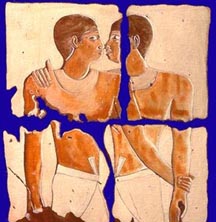Egyptologist Ahmed Moussa discovered the tomb of Khnumhotep and Niankhkhnum at Saqqara, Egypt in 1964, during the excavation of the causeway for the pyramid of King Unas. It is the only tomb in the cemetery where men are displayed embracing and holding hands.
Though the couple lived in the middle of the 5th dynasty of Egypt, the debate of what type of couple they were continues on. The two men are depicted holding hands, sitting together, and standing nose to nose. They both had wives and children, but they are rarely depicted on their tomb or shown to the side, out of focus.
“To understand past cultures, we have to examine everything within the context of that time and place. This applies to sexuality and understandings of intimacy -- aspects of modern life that we often think of as hard-wired or unchanging. However, as students of the history of sexuality we know that concepts and understandings change dramatically over time,” said Dr. Thomas A. Foster, author of "Rethinking Rufus: Sexual Violations of Enslaved Men."
Dr. Ida Jones, Morgan State University archivist and author of "Baltimore Civil Rights Leader Victorine Q. Adams," added another view to the quesion. "Interestingly, the cultural erasures caused by European colonialism have been used to argue for and against the interpretations of couples, such as the Egyptian example. Some scholars argue that 19th and early 20th century Europeans wrote histories of ancient Egypt that erased the same-gender bonds among Egyptian men and women because of their own bias and European homophobia.”
The Tomb Of Niankhkhnum and Khnumhotep

She continued, “Other scholars have argued that to see the two men as anything other than friends is a form of contemporary European colonialism and might be projecting a Western gay agenda on our histories of Ancient Egypt. This tension replicates itself across the globe and is yet more damage (to our histories) caused by colonialism.”
Foster joined Jones about coming to knee-jerk conclusions. Foster added, “In this specific case, some scholars have dismissed the possibility of the two men being a couple, asserting that they were brothers -- or asserting that they were friends. They may have done so because they were using a modern anti-gay bias. There are striking parallels between this male couple and to old English burials and also to early American same-sex couples so it's no surprise that this Egyptian example is also open to interpretations. I would argue that we have to avoid closing down possible explanations that are based only on modern biases (pro or anti gay).”
Read More
Foster joined Jones about coming to knee-jerk conclusions. Foster added, “In this specific case, some scholars have dismissed the possibility of the two men being a couple, asserting that they were brothers -- or asserting that they were friends. They may have done so because they were using a modern anti-gay bias. There are striking parallels between this male couple and to old English burials and also to early American same-sex couples so it's no surprise that this Egyptian example is also open to interpretations. I would argue that we have to avoid closing down possible explanations that are based only on modern biases (pro or anti gay).”
Read More
Advertisers | Contact Us | Events | Links | Media Kit | Our Company | Payments Pier
Press Room | Print Cover Stories Archives | Electronic Issues and Talk Radio Archives | Writer's Guidelines






